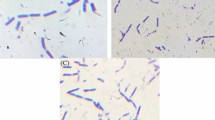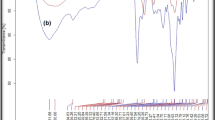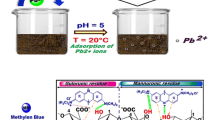Abstract
In the present communication, we report a comparative study of Cr (VI) removal using biologically synthesized nano zero valent iron (BS-nZVI) and chemically synthesized nZVI (CS-nZVI), both immobilized in calcium alginate beads. The parameters like initial Cr (VI) concentration, nZVI concentration, and the contact time for Cr (VI) removal were optimized based on Box–Behnken design (BBD) by response surface modeling at a constant pH 7. Under the optimized conditions (concentration of nZVI = 1000 mg L−1, contact time = ∼80 min, and initial concentration of Cr (VI) = 10 mg L−1), the Cr (VI) removal by the immobilized BS-nZVI and CS-nZVI alginate beads was 80.04 and 81.08 %, respectively. The adsorption of Cr (VI) onto the surface of alginate beads was confirmed by scanning electron microscopy with energy-dispersive x-ray spectroscopy (SEM-EDX), Fourier transform infrared spectroscopy (FT-IR), and Brunauer–Emmett–Teller (BET) analysis. The applicability of the process using both the sorbents was successfully test medium Cr (VI) spiked environmental water samples. In order to assess the ecotoxic effects of nZVI, the decline in cell viability, generation of intracellular reactive oxygen species (ROS), cell membrane damage, and biouptake was studied at 1000 mg L−1 concentration, with five indigenous bacterial isolates from chromium-contaminated lake sediments and their consortium.





Similar content being viewed by others
References
Agrafioti E, Kalderis D, Diamadopoulos E (2014) Arsenic and chromium removal from water using biochars derived from rice husk, organic solid wastes and sewage sludge. J Environ Manag 133:309–314
Allabaksh MB, Mandal BK, Kesarla MK, Kumar KS, Reddy PS (2010) Preparation of stable zero valent iron nanoparticles using different chelating agents. J Chem Pharm Res 2(5):67–74
Bezbaruah AN, Krajangpan S, Chisholm BJ, Khan E, Bermudez JJE (2009) Entrapment of iron nanoparticles in calcium alginate beads for groundwater remediation applications. J Hazard Mater 166:1339–1343
Brown DM, Wilson MR, MacNee W, Stone V, Donaldson K (2001) Size-dependent proinflammatory effects of ultrafine polystyrene particles: a role for surface area and oxidative stress in the enhanced activity of ultrafines. Toxicol Appl Pharm 175(3):191–199
Chaudière J, Ferrari-Iliou R (1999) Intracellular antioxidants: from chemical to biochemical mechanisms. Food Chem Toxicol 37(9):949–962
Davis AP, Bhatnagar V (1995) Adsorption of cadmium and humic acid onto hematite. Chemosphere 30:243–256
Esfahani AR, Hojati S, Azimi A, Farzadian M, Khataee A (2014) Enhanced hexavalent chromium removal from aqueous solution using a sepiolite-stabilized zero-valent iron nanocomposite: impact of operational parameters and artificial neural network modeling. J Taiwan Inst Chem Eng: 88–98
Geranio L (2007) Review of zero valent iron and apatite as reactive materials for permeable reactive barrier. Term Paper: 07
Gopalakannana V, Viswanathan N (2015) Synthesis of magnetic alginate hybrid beads for efficient chromium (VI) removal. Int J Biol Macromol 72:862–867
Hiemstra T, Van Riemsdijk WH (1999) Surface structural ion adsorption modeling of competitive binding of oxy anions by metal hydroxides. J Colloid Interface Sci 210:182–193
Huang L, Zhou S, Jin F, Huang J, Bao N (2014) Characterization and mechanism analysis of activated carbon fiber felt-stabilized nano scale zero-valent iron for the removal of Cr (VI) from aqueous solution. Colloid Surf A: Physicochem Eng Asp 447:59–66
Idris A, Hassan N, Ismail NSM, Misran E, Yusof NM, Ngomsik AF, Bee A (2010) Photo catalytic magnetic separable beads for chromium (VI) reduction. Water Res 44:1683–1688
Janaki V, Shin MN, Kim SH, Lee KJ, Cho M, Ramasamy AK, Oh BT, Kannan SK (2014) Application of poly aniline/bacterial extra cellular polysaccharide nano composite for removal and detoxification of Cr (VI). Cellul 21:463–472
Jang MH, Lim M, Hwang YS (2014) Potential environmental implications of nanoscale zero-valent iron particles for environmental remediation. Environ Health Toxicol 29:e2014022
Kadar E, Tarran GA, Jha AN, Al-Subiai SN (2011) Stabilization of engineered zero-valent nanoiron with Na-acrylic copolymer enhances spermiotoxicity. Environ Sci Technol 45(8):3245–3251
Karthik R, Meenakshi S (2015) Removal of Cr (VI) ions by adsorption onto sodium alginate-poly aniline nano fibers. Int J Biol Macromol 72:711–717
Keenan CR, Goth-Goldstein R, Lucas D, Sedlak DL (2009) Oxidative stress induced by zero-valent iron nanoparticles and Fe (II) in human bronchial epithelial cells. Environ Sci Technol 43(12):4555–4560
Keller AA, Garner K, Miller RJ, Lenihan HS (2012) Toxicity of nano-zero valent iron to freshwater and marine organisms. PloS one 7(8):e43983
Kumar D, Kumari J, Pakrashi S, Dalai S, Raichur AM, Sastry TP, Mukherjee A (2014) Qualitative toxicity assessment of silver nanoparticles on the fresh water bacterial isolates and consortium at low level of exposure concentration. Ecotoxicol Environ Saf 108:152–160
Kumari J, Kumar D, Mathur A, Naseer A, Kumar RR, Chandrasekaran PT, Mukherjee A (2014) Cytotoxicity of TiO2 nanoparticles towards freshwater sediment microorganisms at low exposure concentrations. Environ Res 135:333–345
Lalhmunsiama LC, Tiwari D, Lee SM (2014) Immobilized nickel hexacyano ferrate on activated carbons for efficient attenuation of radio toxic Cs(I) from aqueous solutions. Appl Surf Sci 321:275–282
Lee C, Kim JY, Lee WI, Nelson KL, Yoon J, Sedlak DL (2008) Bactericidal effect of zero-valent iron nanoparticles on Escherichia coli. Environ Sci Technol 42(13):4927–4933
Li XQ, Cao JS, Zhang WX (2008) Immobilization of hexavalent chromium with iron nanoparticles: characterizations with high resolution x-ray photoelectron spectroscopy (HR-XPS). Ind Eng Chem Res 47:2131–2139
Liu T, Zhao L, Suvn D, Tan X (2010) Entrapment of nano scale zero-valent iron in chitosan beads for hexavalent chromium removal from wastewater. J Hazard Mater 184:724–730
Liu T, Wang ZL, Zhao L, Yang X (2012) Enhanced chitosan/Fe 0-nanoparticles beads for hexavalent chromium removal from wastewater. Chem Eng J 189:196–202
Liu Y, Li S, Chen Z, Megharaj M, Naidu R (2014) Influence of zero-valent iron nanoparticles on nitrate removal by Paracoccus sp. Chemosphere 108:426–432
Loyaux-Lawniczak S, Refait P, Ehrhardt JJ, Lecomte P, Génin JMR (2000) Trapping of Cr by formation of ferrihydrite during the reduction of chromate ions by Fe (II)-Fe (III) hydroxysalt green rusts. Environ Sci Technol 34(3):438–443
Lv X, Jiang G, Xue X, Wu D, Sheng T, Sun C, Xu X (2013) Fe(0)-Fe3O4 nano composites embedded poly vinyl alcohol/sodium alginate beads for chromium (VI) removal. J Hazard Mater 262:748–758
Montesinos VN, Quici N, Halac EB, Leyva AG, Custo G, Bengio S, Zampieri G, Litter MI (2014) Highly efficient removal of Cr (VI) from water with nano particulated zero valent iron: understanding the Fe (III)–Cr (III) passive outer layer structure. Chem Eng J 244:569–575
Mueller NC, Braun J, Bruns J, Černík M, Rissing P, Rickerby D, Nowack B (2012) Application of nano scale zero valent iron (NZVI) for groundwater remediation in Europe. Environ Sci Pollut Res 19:550–558
Nel A, Xia T, Mädler L, Li N (2006) Toxic potential of materials at the nano level. Sci 311(5761):622–627
O’Carroll D, Sleep B, Krol M, Boparai H, Kocur C (2013) Nanoscale zero valent iron and bimetallic particles for contaminated site remediation. Adv Water Resour 51:104–122
Oladoja NA, Aboluwoye CO, Oladimeji YB (2008) Kinetics and isotherm studies on methylene blue adsorption onto ground palm kernel coat. Turkish J Eng Environ Sci 32:303–312
Ozturk A, Malkoc E (2014) Adsorptive potential of cationic basic yellow 2 (BY2) dye onto natural untreated clay (NUC) from aqueous phase: mass transfer analysis, kinetic and equilibrium profile. Appl Surf Sci 299:105–115
Pakrashi S, Dalai S, Sabat D, Singh S, Chandrasekaran N, Mukherjee A (2011) Cytotoxicity of Al2O3 nanoparticles at low exposure levels to a freshwater bacterial isolate. Chem Res Toxicol 24(11):1899–1904
Pattanayak M, Nayak PL (2013) Green synthesis and characterization of zero valent iron nanoparticles from the leaf extract of Azadirachtaindica (Neem). World J Nanosci Technol 2:06–09
Paul ML, Samuel J, Chandrasekaran N, Mukherjee A (2014) Preparation and characterization of layer-by-layer coated nano metal oxides-polymer composite film using Taguchi design method for Cr (VI) removal. J Environ Chem Eng 2:1937–1946
Pescod MB (1992) Wastewater treatment and use in agriculture. http://www.fao.org/docrep/t0551e/t0551e04.htm (Accessed on 13 august 2015)”
Phenrat T, Saleh N, Sirk K, Tilton RD, Lowry GV (2007) Aggregation and sedimentation of aqueous nanoscale zerovalent iron dispersions. Environ Sci Technol 41(1):284–290
Phenrat T, Long TC, Lowry GV, Veronesi B (2008) Partial oxidation (“aging”) and surface modification decrease the toxicity of nanosized zerovalent iron. Environ Sci Technol 43(1):195–200
Ponder SM, Darab JG, Mallouk TE (2000) Remediation of Cr (VI) and Pb (II) aqueous solutions using supported, nano scale zero-valent iron. Environ Sci Tech 34:2564–2569
Powell RM, Puls RW, Hightower SK, Sabatini DA (1995) Coupled iron corrosion and chromate reduction: mechanisms for subsurface remediation. Environ Sci Technol 29:1913–1922
Qiu B, Xu C, Sun D, Wei H, Zhang X, Guo J, Wang Q, Rutman D, Guo Z, Wei S (2014) Poly aniline coating on carbon fiber fabrics for improved hexavalent chromium removal. RSC Adv 4(56):29855–29865
Rashmi SH, Madhu GM, Kittur AA, Suresh R, (2013) Synthesis, characterization and application of zero valent iron nanoparticles for the removal of toxic metal hexavalent chromium [Cr (VI)] from aqueous solution. Int J Curr Eng Tech: 37–42
Saccà ML, Fajardo C, Martinez-Gomariz M, Costa G, Nande M, Martin M (2014) Molecular stress responses to nano-sized zero-valent iron (nZVI) particles in the soil bacterium Pseudomonas stutzeri. Plos One 9(2):e89677
Samuel J, Pulimi M, Paul ML, Maurya A, Chandrasekaran N, Mukherjee A (2013) Batch and continuous flow studies of adsorptive removal of Cr (VI) by adapted bacterial consortia immobilized in alginate beads. Bioresour Technol 128:423–430
Savasaria M, Emadi M, Bahmanyar MA, Biparva P (2015) Optimization of Cd (II) removal from aqueous solution by ascorbic acid stabilized zero valent iron nanoparticles using response surface methodology. J Ind Eng Chem 21:1403–1409
Shah S, Chandraprabha MN, Samrat K (2014) Synthesis and characterization of zero valent iron nanoparticles and assessment of its antibacterial activity. Int Rev Appl Biotechnol Biochem 2(1):145–151
Shi LN, Zhang X, Chen ZL (2011) Removal of chromium (VI) from wastewater using bentonite-supported nanoscale zero-valent iron. Water Res 45(2):886–892
Sikdera MT, Mihara Y, Islam MS, Saito T, Tanaka S, Kurasaki M (2014) Preparation and characterization of chitosan–caboxy methyl-b cyclo dextrin entrapped nano zero-valent iron composite for Cu (II) and Cr (IV) removal from wastewater. Chem Eng J 236:378–387
Singh R, Misra V, Singh RP (2011) Synthesis, characterization and role of zero-valent iron nanoparticle in removal of hexavalent chromium from chromium-spiked soil. J Nanopart Res 13:4063–4073
Tripathy A, Raichur AM, Chandrasekaran N, Prathna TC, Mukherjee A (2010) Process variables in biomimetic synthesis of silver nanoparticles by aqueous extract of Azadirachta indica (Neem) leaves. J Nanopart Res 12(1):237–246
Tytłak A, Oleszczuk P, Dobrowolski R (2015) Sorption and desorption of Cr (VI) ions from water by biochars in different environmental conditions. Environ Sci Pollut Res 22(8):5985–5994
Uhlig HH, Revie RW (1985) Corrosion and corrosion control; John Wiley: New York.
United States Environmental Protection Agency (USEPA, 2012) Basic information about chromium in drinking water. http://water.epa.gov/drink/contaminants/basicinformation/chromium.cfm (Accessed on 11 august 2015)
Vieira RS, Meneghetti E, Baroni P, Guibal E, de la Cruz VMG, Caballero A, Castellón ER, Beppu MM (2014) Chromium removal on chitosan-based sorbents—an EXAFS/XANES investigation of mechanism. Mater Chem Phys 146(3):412–417
Von Mersi W, Schinner F (1991) An improved and accurate method for determining the dehydrogenase activity of soils with iodonitrotetrazolium chloride. Biol Fertil Soil 11(3):216–220
Wang H, Joseph JA (1999) Quantifying cellular oxidative stress by dichlorofluorescein assay using microplate reader. Free Radic Biol Med 27(5):612–616
Wang Q, Qian H, Yang Y, Zhang Z, Naman C, Xu X (2010) Reduction of hexavalent chromium by carboxymethyl cellulose-stabilized zero-valent iron nanoparticles. J Contam Hydrol 114(1):35–42
Wu D, Shen Y, Ding A, Mahmood Q, Liu S, Tu Q (2013) Effects of nanoscale zero-valent iron particles on biological nitrogen and phosphorus removal and microorganisms in activated sludge. J Hazard Mater 262:649–655
Yang L, Shi J, Zhou X, Cao S (2015) Hierarchically organization of bio mineralized alginate beads for dual stimuli-responsive drug delivery. Int J Biol Macromol 73:1–8
Acknowledgments
We acknowledge Department of Science and Technology-Science and Engineering Research Board (DST-SERB)[SB/S3/ME/0019/13], Government of India for providing the grant throughout this research work.
Compliance with ethical standards
In this study, neither human participant nor animals were involved.
Conflict of interest
The authors declare that they have no competing interests.
Author information
Authors and Affiliations
Corresponding authors
Additional information
Responsible editor: Philippe Garrigues
K. V. G. Ravikumar and Deepak Kumar contributed equally to this work.
Electronic supplementary material
Below is the link to the electronic supplementary material.
ESM 1
(DOCX 1771 kb)
Rights and permissions
About this article
Cite this article
Ravikumar, K.V.G., Kumar, D., Rajeshwari, A. et al. A comparative study with biologically and chemically synthesized nZVI: applications in Cr (VI) removal and ecotoxicity assessment using indigenous microorganisms from chromium-contaminated site. Environ Sci Pollut Res 23, 2613–2627 (2016). https://doi.org/10.1007/s11356-015-5382-x
Received:
Accepted:
Published:
Issue Date:
DOI: https://doi.org/10.1007/s11356-015-5382-x




